|
3/28/2024 0 Comments The Best Balance Tips for Skaters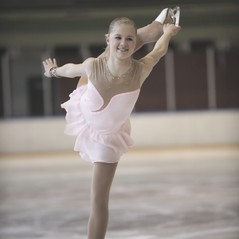 Figure skater showing good balance, smiling and looking happy in a catch spiral Figure skater showing good balance, smiling and looking happy in a catch spiral Improving our balance isn’t reserved for the ice or off-ice conditioning. In fact, everything in the universe is about balance-- the scales of justice our ecosystem education the human body relationships Balance is not about staying in one static state.. it’s a gentle moving back and forth between different sides. Like the pendulum action of the free leg on the American Waltz! Some systems and people can withstand some pretty wild extremes on either side of center… and others are a little more delicate. And most of the time, the level of extremes that we can withstand as humans changes over time, due to age, health, and outside factors. World champion Deanna Stellato-Dudek is able to withstand the intense training of elite pairs skating because she dedicates several hours a day to conditioning AND recovery. The injury and burnout that forced her out of the sport years ago were a result of major imbalance in her training and life. Very few things push the actual limits of our physical balance as much as skating. But what about the balance of our internal systems? Of our minds and our spirits? The 8 limbs of yoga are a practice dedicated to observing and finding that balance. The first two limbs - the yamas and the niyamas - include different mindsets and habits that, when integrated and balanced, lead us on the path to a happy life. Practicing them takes time and awareness. The rest of the limbs are physical and mental practices that help us slow down and observe our habits. They help us practice and integrate the yamas and niyamas, so we can reach that blissful, balanced state of ease. So we can flow into to the blissful zone on and off the ice. In the Skating Yogi Membership we practice the 8 limbs, learning to balance the yamas and niyamas. Join the waiting list today.
0 Comments
10/13/2023 0 Comments It's the Little Things That Count - Five Reasons Skaters Should Practice Basic Skating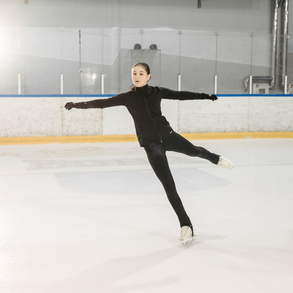 Practicing basic skating skills Practicing basic skating skills I’ve been observing skating progress accounts on social media over the past couple of years, and I’ve noticed how much focus there is on “achieving” new tricks. I haven’t asked why, but I have a hunch it’s the same reason younger skaters and parents fixate on new jumps…
Seasoned coaches will agree, though, that it’s even more important to practice the “simple” stuff. Below are five reasons why. 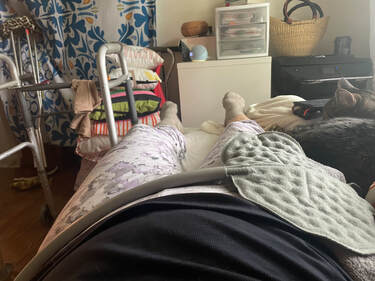 Recovering from gluteus medius repair requires lots of ice... a machine makes it easier. Recovering from gluteus medius repair requires lots of ice... a machine makes it easier. In January, I fooled myself into believing I was ready to try something I wasn’t. I had been dealing with tendinopathy in the right hip for quite some time (close to two years). Believing my body was younger and stronger than it was, I waited way too long to start PT. I kept thinking the pain would get better on its own. When it improved a smidge, I dove into an advanced pose in yoga that I had no business trying. Immediately I felt the pop - like a rubber band that has been stretched too far. And I knew I had seriously messed up. (I wouldn’t know just how much I had screwed up until several months later when it hit me how long and hard recovery would be.) Even though the surgery did what it was supposed to do – repair the tendon attachment and remove the bursa – I won’t know until several more months if it actually did what it was supposed to do. As my surgeon said, “A tear is a tear, and you have to rebuild, and it takes a long time.” Right now, the muscle is simply still too weak and sore to know the final outcome yet. Below are seven important truths I have been reminded of as a result of this surgery, though. They’re important enough to make me grateful that I’ve gone through this process, so keep reading if you want to know them, too. 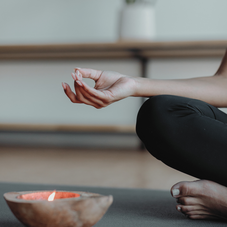 Skater practicing candle gazing to improve focus Skater practicing candle gazing to improve focus Right now in one of my weekly yoga classes for figure skaters, we have a hodge podge of injuries. One skater has a hairline fracture of the wrist, another with a strained foot, and another with a strained hamstring. Then, I have my own injury that has plagued me for months–a gluteus medius tear that will be surgically repaired in a few days. Thank goodness the days of “no pain no gain” in youth sports in the US are disappearing (even if that attitude still persists in many parts of society and in many sports cultures across the world). As my teacher at Yoga East always say, “no pain, no pain” is a much better way to be. Of course, sometimes kids say “owww, it hurts” every time you ask them to use a muscle, and learning to distinguish between effort and the accompanying discomfort vs. actual pain is part of the process of being human and especially of learning to be an athlete. This need for awareness is a major reason why I believe that continuing to practice yoga (in an appropriate, non-harmful way) while injured is so important. I give options to all of the students, especially those with injuries, and let them know that they are in charge–if they don’t feel comfortable trying something or begin to feel any pain, then we need to stop and find a different option for them. We also have been incorporating more exercises for the other limbs of yoga (yamas and niyamas, pranayama, dharana, pratyahara), which are crucial for a well-rounded practice. After all, the essence of practice is simply exploration and awareness of the mind and body, not perfection. 7/1/2023 0 Comments Don't Let These Five Things Stand in the Way of Your Happy, Successful Figure Skating Journey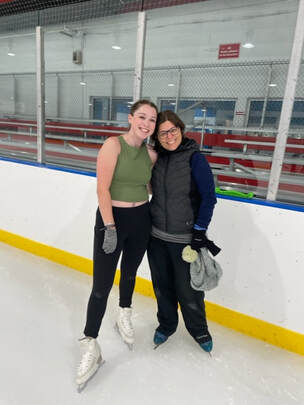 I said to a friend and colleague the other day that when you have a Type A skater who is obsessed with details and needs everything to be perfect, the coach’s job is to help them lighten up a little–to see the beauty and growth in the imperfections; and when you have a skater that doesn’t care about details and just plows ahead “fast and bad” over and over, the coach’s job is to help them see the beauty and growth in the details. As with everything, there should be a happy medium. Or, as the same friend said her mother always says, “Everything in moderation.’ Even the most competitive skaters can’t even experience long-term success if they are panicked about being uncomfortable with making mistakes. And even the most recreational skater can’t be happy long-term if they stop making progress because they won’t slow down to pay attention to the details. Like with everything in life, the goal in skating needs to be a balanced path, and what that looks like will be different for each skater and family. We are each born with a unique set of characteristics and personality traits, so regardless of the formula each coach or family chooses, we all must learn to harness our strengths and develop our weaknesses in order to find that balance. This is what the practice of yoga is all about–finding the right balance of the right ingredients to calm the fluctuations of the mind. For skaters, this translates as learning to train smarter, to ultimately skate better, and enjoy the process more. If yoga is so helpful in this pursuit, then why isn’t everyone doing it? Because not everyone has the same experience with yoga! In my time teaching yoga to figure skaters, these are some of the most common barriers that stop skaters from connecting with yoga and experiencing true transformation. 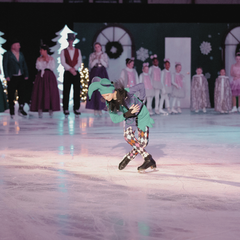 The Jester Doll takes a bow during the Nutcracker on Ice The Jester Doll takes a bow during the Nutcracker on Ice It’s easy to get down on ourselves in this sport because it’s so freaking difficult. There are so many ways a skill can go wrong - spins travel, turns scrape, jumps don’t go up, your feet don’t lean the right way or move quickly enough or move too quickly, the free leg bends, the arms get lost, the head wants to take the lead on takeoff, and your bum can hit the ground at any time. Even if we love the day-to-day grind and working ourselves to the bone–and you have to if you want to make any real progress– there will still be hard moments, weeks, months, and seasons. There will be times when we trip over our toe picks, fall on our kneecaps, can’t remember the steps, kick ourselves in the shin, slip off the heel, split a chin, have an asthma attack, develop tendonitis, collide with another skater, and maybe even break a bone or get a concussion. We get a goal in mind to motivate ourselves, and we know that progress is not a straight line, but when the bummers pile up, and it starts to seem that everyone else is having better days and making more progress than you... how do you keep going? For some adult skaters maybe it’s a little easier than for adolescents–for many adults, skating is their happy place outside of work and family stressors. But for teen and tween skaters who don’t yet have the gift of years to teach them perspective, it’s easy to look at someone else’s journey and feel dejected. Since 2020 one difficult situation after another has come my way. Some have been life-and-death situations, others financial, others mental and emotional, and others have simply been life-changing. And what I’ve come to really see from all of this is that there is a lot of suffering in the world. Everyone on this planet is dealing with something–some way more than others–and none of our blessings are guaranteed. Not a single one. At the time of writing this, I have not been on the ice or able to do a an asana based yoga practice in over 8 weeks due to a hip injury. I will soon have surgery, which will potentially mean another 5 months off. It is well-documented that exercise is a key component of physical and mental health. For many of us, skating is the main form of exercise to help us manage life’s daily stressors and keep our brains happy. For me, yoga is even more important for my mental health than skating. So, when we can’t skate or practice asana (the physical postures), or when we find ourselves feeling down and dejected about skating (or anything), what can we do to help? For me, the answer has been to practice gratitude. That may sound silly, because why be grateful when things have plummeted downhill? I certainly don't mean to deny your feelings in a “good vibes only” sort of way. Recognizing, acknowledging, and releasing emotions is key to our health. However, I also believe we can and should always find something to be grateful for. Since I have not been able to practice asana for what feels like a very long time, and I make efforts not to dwell on the negative, I have made gratitude a key component of my daily routine. (It’s all about where we direct our energy (brahmacharya). So, even though my hip pain is pretty constant, in some ways I feel better than I have in years. With gratitude, optimism is sustainable. 6/2/2023 0 Comments Do This Simple Breathing Exercise Anywhere to Regulate Emotions and Train Smarter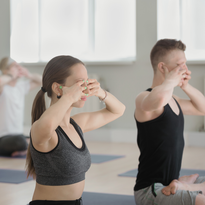 Figure Skaters practice the Bee's Breath (Brhramari) Pranayama as part of their off-ice training Figure Skaters practice the Bee's Breath (Brhramari) Pranayama as part of their off-ice training You’re on a crowded session with the music blaring, and no one seems to be paying attention. You are stressed over schoolwork and are starting a new job this weekend, too. You just really, really wanted to work on your lutz (single, double, or triple?) this session, but a beginner keeps spinning in the lutz corner and a group of teens is full-on procrastination via socialization in the other. When you finally spot an opening to put a jump up, you’re already so agitated that the attempt turns into a massive flop. You need a quick exercise to get you back on track before trying again. Sure, a jump drill sometimes helps redirect your thoughts, but this agitation you’re feeling at this moment isn’t technical. It’s physiological…. Tightness in the chest, shallow breathing, tense shoulders, legs on the ready. Like a cat ready to pounce on its prey, you are ready to pounce into the opening in the traffic for that jump. Except… you are attempting a very technical skill that requires full-body coordination. And you must land on an ice knife with beauty and precision. Skating should be your happy place, not the source of your stress! There are simply too many stimuli! If only you could just block out the chatter, slow the breath, relax the shoulders, and calm the racing thoughts. The Bee’s Breath (Bhramari) technique - can help.  Young figure skater at peace with the learning process and content with her skating journey Young figure skater at peace with the learning process and content with her skating journey We are figure skaters because we love figure skating, but very often we do things that steal the joy from our experience. We focus on our competitors, badmouth ourselves, beat ourselves up over both big and small mistakes, make excuses for bad habits that we have the power to change, fixate on the things we don’t like about our image (because societal pressure tells us we should look a certain way), spend countless hours scrolling social, and then stay up way too late because we are ruminating over the negative things we’ve experienced throughout the day. It’s not our fault–we are biologically programmed to remember negative information and experiences more easily than positive ones. This is called the negativity bias, and it’s pretty powerful. Just because we have a biological negativity bias doesn’t mean we can’t overcome the negative, though. It’s not easy–some studies estimate that we need at least 5-7 times the positive input for each negative one. The more ingrained the negative experience, the harder it is to change. We are figure skaters, though… we were born ready to tackle the hard! Thanks to neuroplasticity, we can rewire connections in the brain not just in childhood, but well into adulthood, too. First, we have to become aware of our habits, then practice replacing them with more positive and productive habits, and finally, surround ourselves with tools and like-minded people to help us in the process. Yoga can be a big help in this process for several reasons. First, studies show what yogis already know–a regular practice of yoga that includes asana, meditation, and breathwork protects and strengthens the brain . In other words, yoga and neuroplasticity go hand in hand. Second, as I’ve written about many times, the purpose of yoga is to guide us on a path to a fulfilling, happy life, and the entire framework of the 8 limbs is designed for this purpose. (See image below) The mechanism of yoga teaches us to pause and still the mind, which helps us slow down long enough to recognize and observe our habits. And since the first tenet of the 8-limbed path of yoga is ahimsa-non-harm, it makes sense that we would work to stop the harmful habits, thoughts, and behaviors. Then, being honest with ourselves (satya) enough to avoid the consumption of negative energies and ideas (saucha) and direct our energy toward helpful thoughts and behaviors (brahmacharya) with fervor (tapas), we can change our habits. Let’s start by eliminating these three harmful habits that I often see in skating. Yoga is perhaps the most important component of off-ice training for a well-balanced figure skater.
This is not to say that mental training, conditioning, plyometrics, nutrition, off-ice spinning, and off-ice jump training are not important. It’s all important! And as skating folks–coaches, parents, and skaters–we have to juggle our time, money, and energies, based on all the factors and realities of our current situation. What’s right for one moment or goal, may not be a top priority for another moment. Of all the off-ice training a skater might do, though, yoga is the most well-rounded, holistic, all-encompassing piece. Yoga, when taught well, is about slowing down to cultivate awareness and self-knowledge. Yoga is the off-ice training that helps skaters assimilate all the other aspects of training, while also helping them develop an inner confidence, calm, and love that will help them withstand the chaos and frenetic pace of a highly competitive sport and world. The framework I use to teach yoga to figure skaters is based on Patanjali’s 8 limbs of yoga. This means that I teach positive mindset and training habits, philosophy, breathwork, focus, and concentration, as well as physical postures. Because while yoga is not really about developing a deeper backbend or touching your toes (even though these things often happen), it is very true that most skaters find it easiest to begin studying yoga through movement and asana (physical postures). It’s what they’re used to and what makes the most sense to them! So, I’ve compiled my favorite asanas for figure skaters to use as a starting point for their yoga practice. These asanas all have strong applications to movements or positions on the ice, so they should be familiar to most skating folks. This is the last installment of a 3-part series teaching a comprehensive list of my top picks of yoga poses (asanas) for figure skaters. To learn about the other asanas, visit here for Part I and here for Part II. 5/12/2023 0 Comments Yoga Training for Figure Skaters is Not What You Think - and Top Asanas for Skaters Part II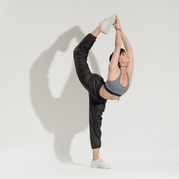 A skater looking blissful while practicing their Biellmann A skater looking blissful while practicing their Biellmann When skating folks think of yoga, most of us picture a Biellmann, Y, I, or pancake. Maybe we even picture Kamila Valieva or some other uber-flexible athlete looking blissful in one of these positions. While it’s true that many yoga postures are similar to these well-known feats of flexibility, the main purpose of yoga is NOT THE POSE. You read that right. It was never really about the poses! It is true that yoga has been around for thousands of years, and that different traditions of yoga from different era and parts of India have different frameworks and beliefs. It is also true that there is no known mention of most of the modern physical yoga postures until the 20th century.
Several postures have been found engraved on ancient temples in India, and only 15 postures (yes! only 15!) were mentioned in the Hatha Yoga Pradipika (an authoritative yoga text from the 15th century). But the Hatha Yoga Pradipika and Patanjali's Yoga Sutras make it clear that the physical practice, the asana, is to help the yogi learn to control and discipline the mind and body. The most commonly cited yoga text and framework used today is the 8 limbs of yoga outlined in Patanjali's Yoga Sutras, which is the framework that I use for applying yoga to skating. (For a more in-depth explanation of the 8 limbs and a visual application to the skating journey, visit this post.) As with most traditions, yoga has evolved throughout the centuries, with different lineages of teachers filtering their teaching through their own experiences. What has remained true, though, is that yoga's purpose is to help you lead a happy, purposeful life, generally in service to others and to your interpretation of a higher purpose or power. It is NOT about being able to achieve lotus position, or stand up out of a backbend, or have an Instagram worthy Biellmann position. Yoga is the practice, and yoga is the destination. In other words, the practice is the path… For skaters, the yogic path very closely parallels the skating journey... It is showing up every day, putting in the work with excitement and joy, without being attached to the outcome. It is practicing the balance of effort and ease, contentment and burning drive. It is being ok with the unknown, giving up the illusion of control, and facing new circumstances with curiosity and grace. All of this is what leads to moments of bliss. And you don’t have to put your blade to your ear to be able to do that! Any skater can practice yoga and learn to feel that they can succeed at whatever their coaches and their life throws their way. |
Author // the skating yogiMy name is Sarah Neal. I have been immersed in the world of figure skating for over four decades. I have seen firsthand the abuse that happens at the higher levels of our sport and experienced how that trickles down into unhealthy training practices and habits at the grassroots. I have seen this play out in the operations of the very institutions that control our sport. Whether for a profession or hobby, pursuing skating should be a joyful, rewarding process, an opportunity for athletic and personal growth, and a place to build lasting friendships. Archives
March 2024
CategoriesAll Athlete Well Being Athlete Well-Being Deep Connections Embodied Movement And Meditation Practices Life After Competition Mindful Living |
Search by typing & pressing enter

 RSS Feed
RSS Feed